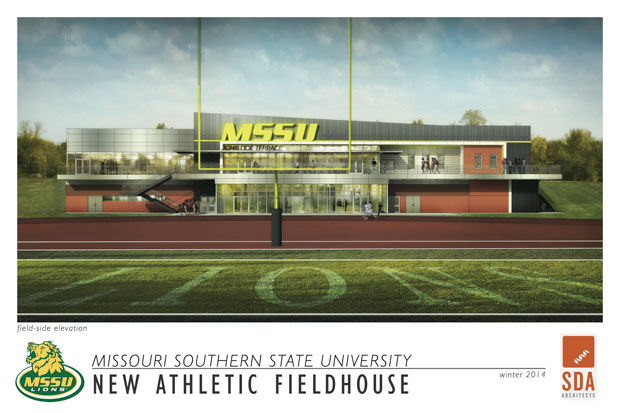Several additions coming to campus by Summer 2015
A computer rendering shows the new multi-purpose fieldhouse that is being built on the north end zone of the football field
It was 2010 when the last major building project at Missouri Southern was completed, but over the last few months the Physical Plant has been working to change that. While the new residence halls are stealing the spotlight in regard to campus additions, several other projects are beginning to take form.
FEMA SHELTER
Around the time the new residence halls were approved, Missouri Southern also made a decision to construct a FEMA shelter on the dorm side of campus. The progress of the residence hall has since taken precedence, but according to Robert Harrington, director of the physical plant, the ground breaking should occur soon.
“The shelter is an open building with no partitions other than the bathrooms,” said Harrington. “There is a small section we will be able to use as offices, but it’s essentially just one large room.”
The shelter is 12,500 square feet and can hold 2,000 people. As well as serving as a storm shelter, student activities will be able to use the building to host events.
The total cost for the construction of the new shelter is $2.1 million. It is expected to be finished in July 2015.
END ZONE FACILITY
The end zone facility is a 48,000 square foot, two-story building that is being built on the north end zone of the football field. It will house locker rooms for football, baseball and softball and feature weight and training rooms. The second floor will have offices for athletics and film rooms, as well as a large classroom that is referred to as the alumni room.
“The alumni room will basically be for the president and VIPs who attend games,” said Harrington. “It’s all glass front and looks out over the field.”
Along with the building, a new parking lot is being built. The end zone facility is scheduled to be finished in May 2015. The total cost of the end zone facility is $8.2 million.
BASEBALL STADIUM
A new baseball stadium is another sports-related build that will be under way soon. The physical plant has selected a construction company and an architect firm to conduct the work.
“We are in the process of very preliminary design work right now and should break ground on it by the first of October,” said Harrington.
The construction of the field is weather dependent, but Harrington hopes it will be finished in early spring.
The cost of the baseball stadium is $2.4 million, but a large portion of that came from the Missouri Southern Foundation, which raised funds for the field.
RESIDENCE HALLS
Construction on the residence halls has been going smoothly for several months, and Harrington now expects the new complex will be completely finished by July 1. The switch from traditional construction on the walls to a panelized system where they are assembled upon delivery has sped the process up considerably.
“I would say the new residence halls are our biggest project right now,” said Harrington. “The new complex is comprised of six buildings, 51 apartments, 201 beds and a courtyard.”
The total cost of the complex is $14 million.
STREET CROSSING
Another issue Harrington is working on is an attempt to find a safe way for students to cross from the two main parking lots to the criminal justice building.
The problem is due in large part to the closure of a section of the parking lot in front of the criminal justice building. Students are parking in the two main lots and running across the street to get to class, but there is no crosswalk in the heavily trafficked area, making the attempt to cross a dangerous event.
“With parking how it is the first few weeks, it’s pretty hard to find a spot by the criminal justice building,” said Jordon Miller, junior criminal justice major. “Going across Newman is like playing real-life Frogger.”
Harrington has been in contact with the Missouri Department of Transportation (Newman Road is operated by the state) to discuss the safest and most efficient way for students to cross the street.
“We hope to put up either a blinking yellow light to caution students or signs that warn for crossing pedestrians,” said Harrington.
MODOT’s biggest concern is that they don’t want to make the situation worse.
There would only be a need for a temporary fix; the tunnel will re-open upon the completion of the residence halls.
Your donation will support the student journalists of Missouri Southern State University. Your contribution will allow us to purchase equipment and cover our annual website hosting costs.
















